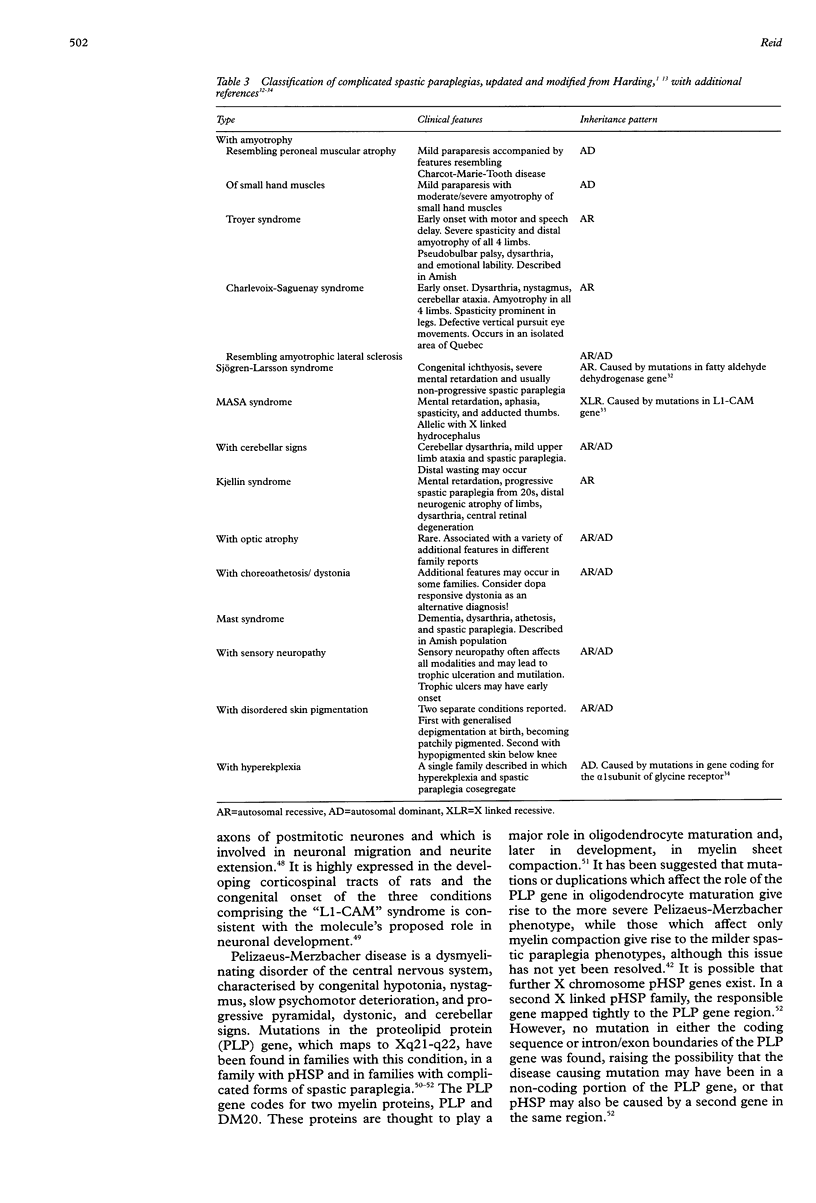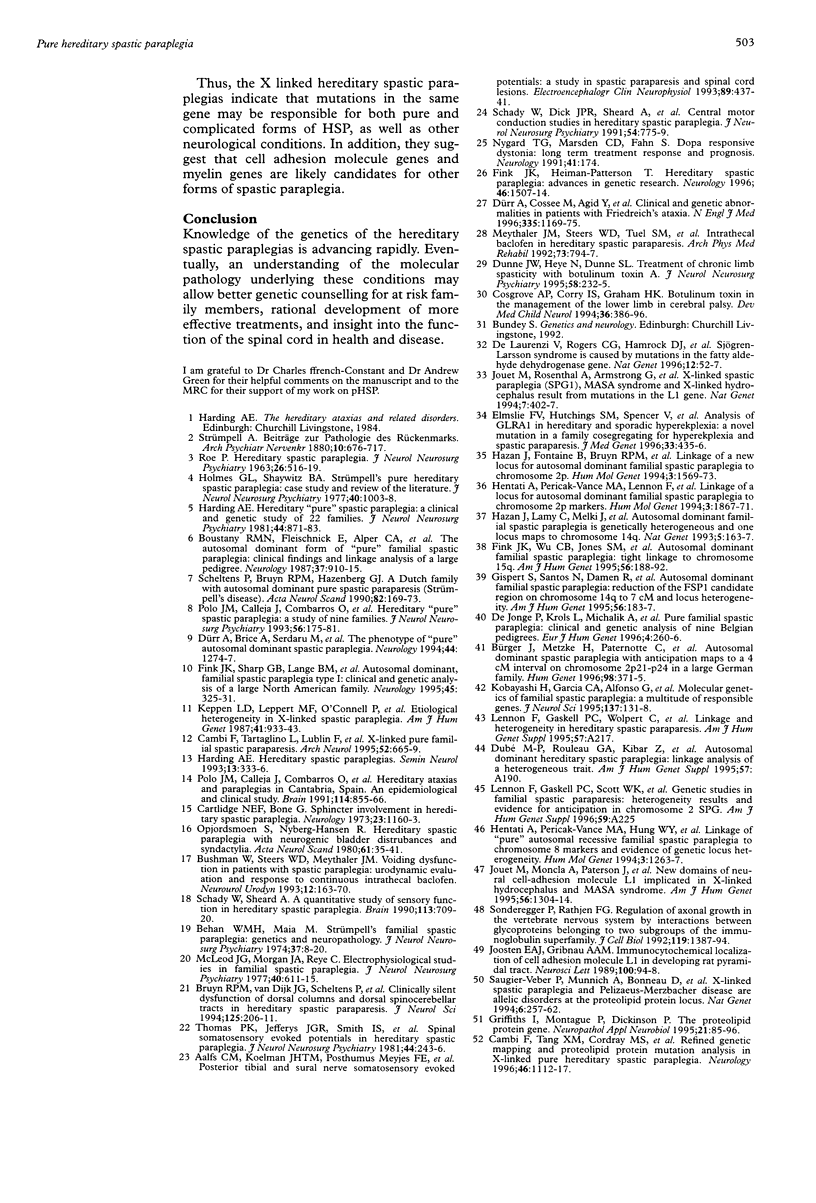Full text
PDF




Selected References
These references are in PubMed. This may not be the complete list of references from this article.
- Aalfs C. M., Koelman J. H., Posthumus Meyjes F. E., Ongerboer de Visser B. W. Posterior tibial and sural nerve somatosensory evoked potentials: a study in spastic paraparesis and spinal cord lesions. Electroencephalogr Clin Neurophysiol. 1993 Dec;89(6):437–441. doi: 10.1016/0168-5597(93)90118-9. [DOI] [PubMed] [Google Scholar]
- Behan W. M., Maia M. Strümpell's familial spastic paraplegia: genetics and neuropathology. J Neurol Neurosurg Psychiatry. 1974 Jan;37(1):8–20. doi: 10.1136/jnnp.37.1.8. [DOI] [PMC free article] [PubMed] [Google Scholar]
- Boustany R. M., Fleischnick E., Alper C. A., Marazita M. L., Spence M. A., Martin J. B., Kolodny E. H. The autosomal dominant form of "pure" familial spastic paraplegia: clinical findings and linkage analysis of a large pedigree. Neurology. 1987 Jun;37(6):910–915. doi: 10.1212/wnl.37.6.910. [DOI] [PubMed] [Google Scholar]
- Bruyn R. P., van Dijk J. G., Scheltens P., Boezeman E. H., Ongerboer de Visser B. W. Clinically silent dysfunction of dorsal columns and dorsal spinocerebellar tracts in hereditary spastic paraparesis. J Neurol Sci. 1994 Sep;125(2):206–211. doi: 10.1016/0022-510x(94)90037-x. [DOI] [PubMed] [Google Scholar]
- Bushman W., Steers W. D., Meythaler J. M. Voiding dysfunction in patients with spastic paraplegia: urodynamic evaluation and response to continuous intrathecal baclofen. Neurourol Urodyn. 1993;12(2):163–170. doi: 10.1002/nau.1930120210. [DOI] [PubMed] [Google Scholar]
- Bürger J., Metzke H., Paternotte C., Schilling F., Hazan J., Reis A. Autosomal dominant spastic paraplegia with anticipation maps to a 4-cM interval on chromosome 2p21-p24 in a large German family. Hum Genet. 1996 Sep;98(3):371–375. doi: 10.1007/s004390050223. [DOI] [PubMed] [Google Scholar]
- Cambi F., Tartaglino L., Lublin F., McCarren D. X-linked pure familial spastic paraparesis. Characterization of a large kindred with magnetic resonance imaging studies. Arch Neurol. 1995 Jul;52(7):665–669. doi: 10.1001/archneur.1995.00540310035013. [DOI] [PubMed] [Google Scholar]
- Cartlidge N. E., Bone G. Sphincter involvement in hereditary spastic paraplegia. Neurology. 1973 Nov;23(11):1160–1163. doi: 10.1212/wnl.23.11.1160. [DOI] [PubMed] [Google Scholar]
- Cosgrove A. P., Corry I. S., Graham H. K. Botulinum toxin in the management of the lower limb in cerebral palsy. Dev Med Child Neurol. 1994 May;36(5):386–396. doi: 10.1111/j.1469-8749.1994.tb11864.x. [DOI] [PubMed] [Google Scholar]
- De Jonghe P., Krols L., Michalik A., Hazan J., Smeyers G., Löfgren A., Weissenbach J., Martin J. J., Van Broeckhoven C. Pure familial spastic paraplegia: clinical and genetic analysis of nine Belgian pedigrees. Eur J Hum Genet. 1996;4(5):260–266. doi: 10.1159/000472212. [DOI] [PubMed] [Google Scholar]
- De Laurenzi V., Rogers G. R., Hamrock D. J., Marekov L. N., Steinert P. M., Compton J. G., Markova N., Rizzo W. B. Sjögren-Larsson syndrome is caused by mutations in the fatty aldehyde dehydrogenase gene. Nat Genet. 1996 Jan;12(1):52–57. doi: 10.1038/ng0196-52. [DOI] [PubMed] [Google Scholar]
- Dunne J. W., Heye N., Dunne S. L. Treatment of chronic limb spasticity with botulinum toxin A. J Neurol Neurosurg Psychiatry. 1995 Feb;58(2):232–235. doi: 10.1136/jnnp.58.2.232. [DOI] [PMC free article] [PubMed] [Google Scholar]
- Dürr A., Brice A., Serdaru M., Rancurel G., Derouesné C., Lyon-Caen O., Agid Y., Fontaine B. The phenotype of "pure" autosomal dominant spastic paraplegia. Neurology. 1994 Jul;44(7):1274–1277. doi: 10.1212/wnl.44.7.1274. [DOI] [PubMed] [Google Scholar]
- Dürr A., Cossee M., Agid Y., Campuzano V., Mignard C., Penet C., Mandel J. L., Brice A., Koenig M. Clinical and genetic abnormalities in patients with Friedreich's ataxia. N Engl J Med. 1996 Oct 17;335(16):1169–1175. doi: 10.1056/NEJM199610173351601. [DOI] [PubMed] [Google Scholar]
- Elmslie F. V., Hutchings S. M., Spencer V., Curtis A., Covanis T., Gardiner R. M., Rees M. Analysis of GLRA1 in hereditary and sporadic hyperekplexia: a novel mutation in a family cosegregating for hyperekplexia and spastic paraparesis. J Med Genet. 1996 May;33(5):435–436. doi: 10.1136/jmg.33.5.435. [DOI] [PMC free article] [PubMed] [Google Scholar]
- Fink J. K., Heiman-Patterson T., Bird T., Cambi F., Dubé M. P., Figlewicz D. A., Fink J. K., Haines J. L., Heiman-Patterson T., Hentati A. Hereditary spastic paraplegia: advances in genetic research. Hereditary Spastic Paraplegia Working group. Neurology. 1996 Jun;46(6):1507–1514. doi: 10.1212/wnl.46.6.1507. [DOI] [PubMed] [Google Scholar]
- Fink J. K., Sharp G. B., Lange B. M., Wu C. B., Haley T., Otterud B., Peacock M., Leppert M. Autosomal dominant, familial spastic paraplegia, type I: clinical and genetic analysis of a large North American family. Neurology. 1995 Feb;45(2):325–331. doi: 10.1212/wnl.45.2.325. [DOI] [PubMed] [Google Scholar]
- Fink J. K., Wu C. T., Jones S. M., Sharp G. B., Lange B. M., Lesicki A., Reinglass T., Varvil T., Otterud B., Leppert M. Autosomal dominant familial spastic paraplegia: tight linkage to chromosome 15q. Am J Hum Genet. 1995 Jan;56(1):188–192. [PMC free article] [PubMed] [Google Scholar]
- Gispert S., Santos N., Damen R., Voit T., Schulz J., Klockgether T., Orozco G., Kreuz F., Weissenbach J., Auburger G. Autosomal dominant familial spastic paraplegia: reduction of the FSP1 candidate region on chromosome 14q to 7 cM and locus heterogeneity. Am J Hum Genet. 1995 Jan;56(1):183–187. [PMC free article] [PubMed] [Google Scholar]
- Griffiths I. R., Montague P., Dickinson P. The proteolipid protein gene. Neuropathol Appl Neurobiol. 1995 Apr;21(2):85–96. doi: 10.1111/j.1365-2990.1995.tb01034.x. [DOI] [PubMed] [Google Scholar]
- Harding A. E. Hereditary "pure" spastic paraplegia: a clinical and genetic study of 22 families. J Neurol Neurosurg Psychiatry. 1981 Oct;44(10):871–883. doi: 10.1136/jnnp.44.10.871. [DOI] [PMC free article] [PubMed] [Google Scholar]
- Harding A. E. Hereditary spastic paraplegias. Semin Neurol. 1993 Dec;13(4):333–336. doi: 10.1055/s-2008-1041143. [DOI] [PubMed] [Google Scholar]
- Hazan J., Fontaine B., Bruyn R. P., Lamy C., van Deutekom J. C., Rime C. S., Dürr A., Melki J., Lyon-Caen O., Agid Y. Linkage of a new locus for autosomal dominant familial spastic paraplegia to chromosome 2p. Hum Mol Genet. 1994 Sep;3(9):1569–1573. doi: 10.1093/hmg/3.9.1569. [DOI] [PubMed] [Google Scholar]
- Hazan J., Lamy C., Melki J., Munnich A., de Recondo J., Weissenbach J. Autosomal dominant familial spastic paraplegia is genetically heterogeneous and one locus maps to chromosome 14q. Nat Genet. 1993 Oct;5(2):163–167. doi: 10.1038/ng1093-163. [DOI] [PubMed] [Google Scholar]
- Hentati A., Pericak-Vance M. A., Hung W. Y., Belal S., Laing N., Boustany R. M., Hentati F., Ben Hamida M., Siddique T. Linkage of 'pure' autosomal recessive familial spastic paraplegia to chromosome 8 markers and evidence of genetic locus heterogeneity. Hum Mol Genet. 1994 Aug;3(8):1263–1267. doi: 10.1093/hmg/3.8.1263. [DOI] [PubMed] [Google Scholar]
- Hentati A., Pericak-Vance M. A., Lennon F., Wasserman B., Hentati F., Juneja T., Angrist M. H., Hung W. Y., Boustany R. M., Bohlega S. Linkage of a locus for autosomal dominant familial spastic paraplegia to chromosome 2p markers. Hum Mol Genet. 1994 Oct;3(10):1867–1871. doi: 10.1093/hmg/3.10.1867. [DOI] [PubMed] [Google Scholar]
- Holmes G. L., Shaywitz B. A. Strumpell's pure familial spastic paraplegia: case study and review of the literature. J Neurol Neurosurg Psychiatry. 1977 Oct;40(10):1003–1008. doi: 10.1136/jnnp.40.10.1003. [DOI] [PMC free article] [PubMed] [Google Scholar]
- Joosten E. A., Gribnau A. A. Immunocytochemical localization of cell adhesion molecule L1 in developing rat pyramidal tract. Neurosci Lett. 1989 May 22;100(1-3):94–98. doi: 10.1016/0304-3940(89)90666-6. [DOI] [PubMed] [Google Scholar]
- Jouet M., Moncla A., Paterson J., McKeown C., Fryer A., Carpenter N., Holmberg E., Wadelius C., Kenwrick S. New domains of neural cell-adhesion molecule L1 implicated in X-linked hydrocephalus and MASA syndrome. Am J Hum Genet. 1995 Jun;56(6):1304–1314. [PMC free article] [PubMed] [Google Scholar]
- Jouet M., Rosenthal A., Armstrong G., MacFarlane J., Stevenson R., Paterson J., Metzenberg A., Ionasescu V., Temple K., Kenwrick S. X-linked spastic paraplegia (SPG1), MASA syndrome and X-linked hydrocephalus result from mutations in the L1 gene. Nat Genet. 1994 Jul;7(3):402–407. doi: 10.1038/ng0794-402. [DOI] [PubMed] [Google Scholar]
- Keppen L. D., Leppert M. F., O'Connell P., Nakamura Y., Stauffer D., Lathrop M., Lalouel J. M., White R. Etiological heterogeneity in X-linked spastic paraplegia. Am J Hum Genet. 1987 Nov;41(5):933–943. [PMC free article] [PubMed] [Google Scholar]
- Kobayashi H., Garcia C. A., Alfonso G., Marks H. G., Hoffman E. P. Molecular genetics of familial spastic paraplegia: a multitude of responsible genes. J Neurol Sci. 1996 May;137(2):131–138. doi: 10.1016/0022-510x(95)00349-7. [DOI] [PubMed] [Google Scholar]
- McLeod J. G., Morgan J. A., Reye C. Electrophysiological studies in familial spastic paraplegia. J Neurol Neurosurg Psychiatry. 1977 Jun;40(6):611–615. doi: 10.1136/jnnp.40.6.611. [DOI] [PMC free article] [PubMed] [Google Scholar]
- Meythaler J. M., Steers W. D., Tuel S. M., Cross L. L., Sesco D. C., Haworth C. S. Intrathecal baclofen in hereditary spastic paraparesis. Arch Phys Med Rehabil. 1992 Sep;73(9):794–797. [PubMed] [Google Scholar]
- Nygaard T. G., Marsden C. D., Fahn S. Dopa-responsive dystonia: long-term treatment response and prognosis. Neurology. 1991 Feb;41(2 ):174–181. doi: 10.1212/wnl.41.2_part_1.174. [DOI] [PubMed] [Google Scholar]
- Opjordsmoen S., Nyberg-Hansen R. Hereditary spastic paraplegia with neurogenic bladder disturbances and syndactylia. Acta Neurol Scand. 1980 Jan;61(1):35–41. doi: 10.1111/j.1600-0404.1980.tb02993.x. [DOI] [PubMed] [Google Scholar]
- Polo J. M., Calleja J., Combarros O., Berciano J. Hereditary "pure" spastic paraplegia: a study of nine families. J Neurol Neurosurg Psychiatry. 1993 Feb;56(2):175–181. doi: 10.1136/jnnp.56.2.175. [DOI] [PMC free article] [PubMed] [Google Scholar]
- Polo J. M., Calleja J., Combarros O., Berciano J. Hereditary ataxias and paraplegias in Cantabria, Spain. An epidemiological and clinical study. Brain. 1991 Apr;114(Pt 2):855–866. doi: 10.1093/brain/114.2.855. [DOI] [PubMed] [Google Scholar]
- ROE P. F. HEREDITARY SPASTIC PARAPLEGIA. J Neurol Neurosurg Psychiatry. 1963 Dec;26:516–519. doi: 10.1136/jnnp.26.6.516. [DOI] [PMC free article] [PubMed] [Google Scholar]
- Saugier-Veber P., Munnich A., Bonneau D., Rozet J. M., Le Merrer M., Gil R., Boespflug-Tanguy O. X-linked spastic paraplegia and Pelizaeus-Merzbacher disease are allelic disorders at the proteolipid protein locus. Nat Genet. 1994 Mar;6(3):257–262. doi: 10.1038/ng0394-257. [DOI] [PubMed] [Google Scholar]
- Schady W., Sheard A. A quantitative study of sensory function in hereditary spastic paraplegia. Brain. 1990 Jun;113(Pt 3):709–720. doi: 10.1093/brain/113.3.709. [DOI] [PubMed] [Google Scholar]
- Scheltens P., Bruyn R. P., Hazenberg G. J. A Dutch family with autosomal dominant pure spastic paraparesis (Strümpell's disease). Acta Neurol Scand. 1990 Sep;82(3):169–173. doi: 10.1111/j.1600-0404.1990.tb04484.x. [DOI] [PubMed] [Google Scholar]
- Sonderegger P., Rathjen F. G. Regulation of axonal growth in the vertebrate nervous system by interactions between glycoproteins belonging to two subgroups of the immunoglobulin superfamily. J Cell Biol. 1992 Dec;119(6):1387–1394. doi: 10.1083/jcb.119.6.1387. [DOI] [PMC free article] [PubMed] [Google Scholar]
- Thomas P. K., Jefferys J. G., Smith I. S., Loulakakis D. Spinal somatosensory evoked potentials in hereditary spastic paraplegia. J Neurol Neurosurg Psychiatry. 1981 Mar;44(3):243–246. doi: 10.1136/jnnp.44.3.243. [DOI] [PMC free article] [PubMed] [Google Scholar]


